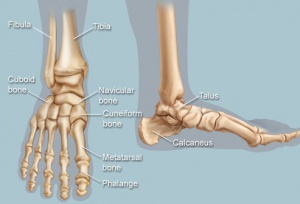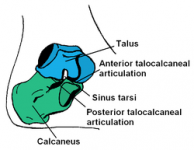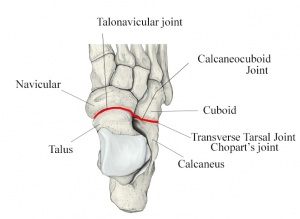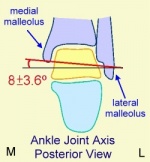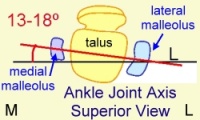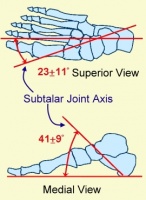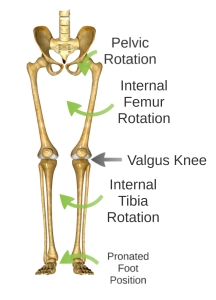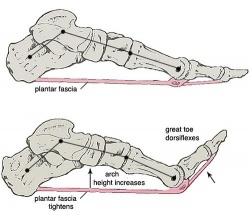Foot and Ankle Structure and Function
Original Editor - Vinit Kothekar
Top Contributors - Vinit Kothekar, Wanda van Niekerk, Kim Jackson, Admin, Evan Thomas, Lucinda hampton, Chelsea Mclene, Candace Goh, Rachael Lowe, Simisola Ajeyalemi, Rucha Gadgil, Jess Bell, Khloud Shreif, 127.0.0.1, Ewa Jaraczewska, Cath Young, Priyanka Chugh and WikiSysop
Anatomy[edit | edit source]
Foot & ankle form a complex system which consists of 26 bones, 33 joints and more than 100 muscles, tendons and ligaments. It functions as a rigid structure for weight bearing and it can also function as a flexible structure to conform the uneven terrain. Foot and ankle provide various important functions which may include: support of body’s weight, providing balance, acts as a shock absorption, is the first contact to ground and transfer point for ground reaction force, compensates for proximal malalignment and may also substitute hand function in individuals with upper extremity amputations and paralysisCite error: Invalid <ref> tag; name cannot be a simple integer. Use a descriptive title. Foot is subdivided into rearfoot, midfoot and forefoot.
Talocrural (TC) joint[edit | edit source]
It is commonly known as ankle joint. Talocrural joint is formed between Tibia-fibula and Talus. Distal and inferior aspect of tibia – known as plafond – is connected to fibula via tibiofibular ligaments forming a strong mortise which articulates with the talar dome distally. Type of joint – hinge joint. Movements allowed – in sagittal plane, dorsiflexion and plantarflexion.
Subtalar (ST) joint[edit | edit source]
It is also known as talocalcaneal joint and is formed between talus and calcaneus. Three facets of talus - anterior, middle and posterior facets, articulates inferiorly with calcaneus.
Midtarsal (MT) joint[edit | edit source]
Also known as transverse tarsal joints or Chopart’s joint. It is S-shaped joint when viewed from above, and it consists of two joints – Talonavicular joint and Calcaneocuboid joint.
- Talonavicular (TN) JointIt is formed between anterior talar head and concavity on navicular bone. It does not have its own capsule and is the same one as of two anterior talocalcaneal articulations.
- Calcaneocuboid (CC) Joint – It is formed between anterior facet of calcaneus and posterior cuboid. Both articulating surface present convex and concave surface, with joint being convex vertically and concave transversely. Very little movement occur between joint segments.
Tarsometatarsal (TMT) Joint complex[edit | edit source]
Also known as Lisfranc’s joint. The distal tarsal rows including three cuneiform bones and cuboid articulate with base of metatarsals to form TMT complex. It is S-shaped joint and divided into 3 distinct columnsCite error: Invalid <ref> tag; name cannot be a simple integer. Use a descriptive title.
Medial – composed of 1st Metatarsal and medial Cuneiform.
Middle – composed of 2nd and 3rd Metatarsal and intermediate and lateral Cuneiform respectively.
Lateral – composed of 4th and 5th Metatarsal and Cuboid. It also divides the midfoot from forefoot.
Metatarsophalangeal (MTP) joints and Interphalangeal (IP) joints[edit | edit source]
MTP Joints are formed between metatarsal heads and corresponding base of proximal phalanx. Interphalangeal joints of the toes are formed between the phalanges of the toes. Each toe has proximal and distal IP joints except for the great toe which only has one IP joint.
| Joints | Type of Joints | Plane of movement | Motion |
|---|---|---|---|
| TC joint | Hinge joint | Sagittal plane | Dorsiflesxion & Plantarflexion |
| ST joint | Condyloid joint |
Mainly transverse plane Some sagittal plane |
Inversion & Eversion Dorsiflexion & Plantarflexion |
| MT joint |
TN joint - Ball & Socket joint CC joint - modified saddle joint |
Largely in transverse plane Some sagittal plane |
Inversion & Eversion Flexion & Extension |
| TMT joint | Plane joint | ||
| MTP joint | Condyloid joint |
Sagittal plane Some Transverse plane |
Flexion & Extension Abduction & Adduction |
| IP joint | Hinge joint | Sagittal plane | Flexion & Extension |
Kinematics[edit | edit source]
Talocrural joint[edit | edit source]
Tip of anterior malleoli is anterior and superior to lateral malleoli, which makes its axis oblique to both sagittal and frontal plane. The axis of rotation is approximately 13-18o laterally from frontal plane and at angle of 8-10o from transverse planeCite error: Invalid <ref> tag; name cannot be a simple integer. Use a descriptive title,Cite error: Invalid <ref> tag; name cannot be a simple integer. Use a descriptive title. Motion in other planes is required (like horizontal and frontal plane) to achieve a complete motion for plantarflexion and dorsiflexionCite error: Invalid <ref> tag; name cannot be a simple integer. Use a descriptive title. Normal available range for dorsiflexion is 0-30o and plantarflexion range is 0-55o.
Subtalar joint[edit | edit source]
The axis of subtalar joint lies about 42o upward of sagittal plane and about 16 to 23o medial to transverse planeCite error: Invalid <ref> tag; name cannot be a simple integer. Use a descriptive title,Cite error: Invalid <ref> tag; name cannot be a simple integer. Use a descriptive title. Literature presents vast range of subtalar motion ranging from 5 to 65o Cite error: Invalid <ref> tag; name cannot be a simple integer. Use a descriptive title. Average ROM for pronation is 5o and for supination is 20o. Inversion and Eversion ROM has been identified as 30o and 18o, respectivelyCite error: Invalid <ref> tag; name cannot be a simple integer. Use a descriptive title. Total inversion-eversion motion is about 2:1 or 3:2 ratio of inversion-to-eversion movementCite error: Invalid <ref> tag; name cannot be a simple integer. Use a descriptive title.
Midtarsal Joint[edit | edit source]
The midtarsal joint rotates at two axes due to its anatomy which makes its motion complex. Longitudinal axis(A) lies about 15o superior to horizontal plane and about 10o medial to longitudinal plane. And oblique axis(B) lies about 52o superior to horizontal plane and 57o from midline. Longitudinal axis is close to subtalar joint axis and oblique axis is similar to talocrural joint axis.
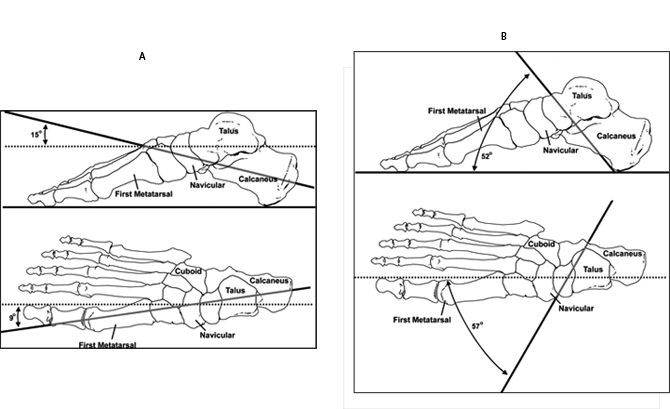
MT joint lockingCite error: Invalid <ref> tag; name cannot be a simple integer. Use a descriptive title, Cite error: Invalid <ref> tag; name cannot be a simple integer. Use a descriptive title – An important function of the foot is propulsion of weight during stance phase. This function is made possible by MT joint locking and unlocking. During heel strike foot needs to be flexible in order to adjust to the surface and MT joint unlocks to provide the flexibility. Whereas later on foot needs to act as rigid lever to propel the weight forward which is made possible by MT joint locking. During pronation/eversion of foot axis of TN and CC joint are parallel to each other which makes it easier for them to independently move and unlocking the MT joint. And the axes cross each other during supination/inversion which locks MT joint making it difficult to move. Blackwood et al concluded in the study that there is increased forefoot movement when calcaneus is everted. This is consisted with MT joint locking mechanism.
Lisfranc Joint Complex[edit | edit source]
The degree of sagittal motion for each TMT joint is presented belowCite error: Invalid <ref> tag; name cannot be a simple integer. Use a descriptive title.
| TMT Joint | Degree of Motion |
| 1st | 1.6o |
| 2nd | 0.6o |
| 3rd | 3.5o |
| 4th | 9.6o |
| 5th | 10.2o |
MTP and IP joints[edit | edit source]
The MTP joints are biaxial and move in sagittal and transverse plane. MTP joints present with a greater sagittal plane movement and very little transverse plane movement. At MTP joints, hyperextension is about 90o and flexion is about 30 to 50o. IP joints are hinge joints which limit motion in one direction.
Arthrokinematics[edit | edit source]
- Talocrural Joint – Talus rolls within mortise during dorsiflexion and plantarflexion. During dorsiflexion, talus rolls anteriorly and it glides posteriorly. While with plantarflexion, talus rolls posteriorly and glides anteriorly.
- Subtalar joint – Secondary to the anatomy of the subtalar joint, coupled motion of dorsiflexion, abduction and eversion produces pronation. Whereas coupled motion of plantarflexion, adduction and inversion produces supination. It presents two point of articulations – anterior talocalcaneal articulation and posterior talocalcaneal articulationCite error: Invalid
<ref>tag; name cannot be a simple integer. Use a descriptive title. During open kinectic chain inversion, calcaneus rolls into inversion and it glides/slides laterally. And during eversion, calcaneus rolls into eversion and it glides/slides medially - Midtarsal joint – For Talonavicular joint, the concave navicular moves on convex talus and hence the roll and glide is in the same direction of movement. Calcaneocuboid joint is a saddle joint and so the direction changes depending on the movement. During flexion-extension, cuboid is concave and calcaneus is convex, hence roll and glide occurs in the same direction as Talonavicular joint. But during abduction-adduction, cuboid is convex and calcaneus is concave, hence roll and glide occurs in opposite direction.
- Lisfranc Joint – Secondary to bony and ligamentous anatomy of the complex, its primary role is stability of the midfoot and has very little movement. It has three distinct arches and main stabilizing structure of TMT joint is a Y-shaped ligament known as Lisfranc’s ligament.
- MTP and IP joints – Glide and roll is in same direction of the movement for MTP joint as concave base of phalanx move on convex head of metatarsal. And same is true for IP joints, where glide and roll is in the same direction as concave distal phalanx moves on convex proximal phalanx.
| Joint | Closed-Packed Position | Open-Packed Position | Capsular Pattern | Concave Surface | Convex Surface |
Concave-convex rule Roll & glide |
|---|---|---|---|---|---|---|
| Talocrural joint | Full dorsiflexion | 10o of plantarflexion and midway between pronation and supination | Limitation of plantarflexion, although clinically dorsiflexion limitation is more common | Proximal - Mortise formed by Tibia, tibiofibular ligament and fibula | Distal - Trochlear surface of Talar dome | Opposite direction |
| Subtalar joint | Full inversion | Inversion/plantarflexion | Limitation of inversion in chronic arthritis. Limitation of eversion in traumatic | Proximal - Anterior, middle and posterior facet of talus | Distal – Calcaneal Anterior, middle and posterior talar articular surface | Opposite direction |
| Talonavicular joint | Full supination | Midway between extreme ROM | Limitation of dorsiflexion, plantarflexion, adduction and internal rotation. | Proximal - Head of Talus | Distal - Concavity on Navicular bone for talus | Same direction |
| Calcaneocuboid joint | Full supination | Midway between extreme ROM | Limitation of dorsiflexion, plantarflexion, adduction and internal rotation. | Distal - Cuboid is concave during flexion-extension. Calcaneus is concave during adduction-abductoin |
Proximal - Calcaneus is convex during flexion-extension. Cuboid is convex during adduction-abduction |
Flexion-extension = Same direction |
| Lisfranc Joint | Full supination | Midway between supination and pronation | ||||
| 1st MTP joint | Hyperextension | Slight (10o) extension | Loss of motion more in extension than flexion | Distal - Base of phalanx | Proxmial - Head of Metatarsal | Same direction |
| 2nd to 5th MTP joint | Maximum flexion | Slight (10o) extension | Loss of flexion | Distal - Base of phalanges | Proximal - Head of metatarsals | Same direction |
| Interphalangeal Joint | Full extension | Slight flexion | Restriction in all direction with more in extension | Distal Phalanx | Proximal Phalanx | Same direction |
Influence on Kinetic Chain[edit | edit source]
As discussed above with MT joint locking, the transition of foot from pronation to supination is an important function that assists in adapting to uneven terrain and acting as a rigid lever during push off. During pronation, MT joint unlocks providing flexibility of the foot and assists in maintaining balance. And during supination, MT joint locks providing rigidity of the foot and maximizing stability. If the foot stuck pronated, this would lead to hypermobility of the midfoot and placing greater demand on the neuromuscular structure stabilize foot and maintaining upright stance. Whereas if the foot is stuck supinated, the midfoot would be hypomobile which would compensate the ability of the foot to adjust to the terrain and increasing demand on surrounding structure to maintain postural stability and balance. Cote et alCite error: Invalid <ref> tag; name cannot be a simple integer. Use a descriptive titleconcluded that postural stability is affected by foot positioning under static and dynamic conditions. Chain reaction occurs secondary to positioning of the foot.
In closed chain movement following kinetic chain reaction with overpronated foot takes place
- Calcaneal eversion
- Adduction and plantarflexion of talus
- Medial rotation of talus
- Medial rotation of tibia and fibula
- Valgus at knee
- Medial rotation of femur
- Anterior tilting of pelvis
In closed chain movement following kinetic chain reaction with oversupinated foot takes place
- Calcaneal inversion
- Abduction and dorsiflexion of talus
- Lateral rotation of talus
- Lateral rotation of tibia and fibula
- Varus at knee
- Lateral rotation of femur
- Posterior tilting of pelvis
Arches of Foot
[edit | edit source]
The arches of foot provide functions of force absorption, base of support and acts as a rigid lever during gait propulsion. The medial longitudinal arch, lateral longitudinal arch and transverse arch are the 3 arches that compromises arches of foot.
Medial Longitudinal Arch (MLA) – It is the longest and highest of all the arches. Bony components of MLA include calcaneus, talus, navicular, the three cuneiform bones and first 3 metatarsal. The arch consists of two pillar: anterior and posterior pillars. Anterior pillar consists of head of first 3 metatarsal heads whereas posterior pillar consists of tuberosity of calcaneus. Plantar aponeurosis forms the supporting beam connecting the two pillarsCite error: Invalid <ref> tag; name cannot be a simple integer. Use a descriptive title. Apex of the MLA is superior articular surface of talus. In addition to plantar aponeurosis the MLA is also supported by spring ligament and deltoid ligament. Tibialis anterior and posterior muscles play an important role in raising the medial border of the arch, whereas flexor hallucis longus acts as bowstring.
Lateral Longitudinal Arch (LLA) – It is the lowest arch and compromises of calcaneus, cuboid and fourth & fifth metatarsal as its bony component. Like MLA the posterior pillar consists of tuberosity of calcaneus whereas the anterior pillar is formed by metatarsal heads of 4th and 5th metatarsals. Plantar aponeurosis, and long & short plantar ligaments provide support for LLA. Peroneus longus tendon plays an important role in maintaining the lateral border of the arch.

Transverse Arch – It is concave in non-weight bearing which runs medial to lateral in midtarsal and tarsometatarsal area. The bony component of the arch consists of metatarsal heads, cuboids and 3 cuneiform bones. The medial and lateral pillars of the arch is formed by medial and lateral longitudinal arch respectively. The arch is maintained by posterior tibialis tendon and peroneus longus tendon which cross the plantar surface from medial to lateral and lateral to medial respectively.
Windlass Mechanism of foot – The plantar aponeurosis acts similarly as windlass mechanism. Windlass is typically a horizontal cylinder that rotates with a crank or belt on a chain or rope to pull a heavy objects. The common use of windlass is seen in pulling the anchor of the ship known as anchor windlass. This mechanism can be seen in foot. When the MTP joints are hyperextended, the plantar aponeurosis becomes taut as it is wrapped around the MTP joints. This actions brings the metatarsal and tarsal bones together converting it into a rigid structure and eventually causing the longitudinal arches to rise. This function is important in providing a rigid lever for gait propulsion during push off.
Biomechanical evaluation[edit | edit source]
Tibial Torsion Measurement/Thigh-foot angle (TFA) – To measure internal or external tibial torsion, patient is positioned in prone lying with knees flexed to 90o. A thigh-foot ankle (TFA) is measured between the line bisecting the posterior thigh and another line bisecting the foot. Normally the angle is betwee 0o to 30o, TFA more than 30o is excessive external tibial torsion and TFA less than 0o is considered internal tibial torsion.
References[edit | edit source]
- ↑ Midtarsal joint axis during pronation. Available from: https://vimeo.com/65147465
